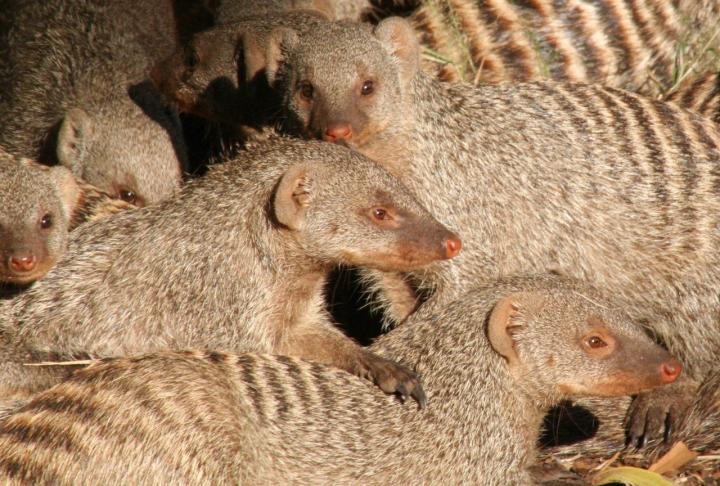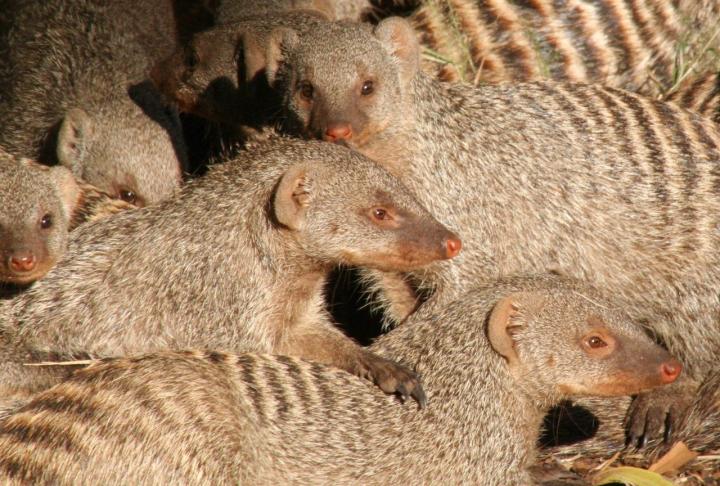
Credit: B. Fairbanks
A novel tuberculosis pathogen, Mycobacterium mungi, closely related to human TB, infects and kills banded mongooses through a surprising route — olfactory communication. Now, a detailed investigation published in the journal Veterinary Pathology provides a window into how this deadly disease moves between mongooses and within the mongoose host.
The team, led by Kathleen Alexander, a professor of wildlife conservation in Virginia Tech's College of Natural Resources and Environment, identified a unique pathological presentation for this tuberculosis pathogen.
Infected anal gland secretions are sniffed or used to mark other mongooses, allowing this tuberculosis pathogen to invade the mongoose host through breaks in the skin or nose. This is the first case of a pathogen being transmitted through olfactory communication networks.
"Mongooses use anal gland secretions to communicate essential information to each other that is fundamental to the survival of their social group," said Alexander. "Our findings highlight the amazing ability of a pathogen to evolve and exploit the behavior of a species to increase transmission, and this has critical implications to our understanding of TB."
From 1999 to 2017, Alexander and her team examined 62 mongooses infected with tuberculosis and found that the most infected areas of the body were the lymph nodes, spleen, and anal glands.
"Given the character and distribution of lesions, we think that the pathogen spreads through the blood, the lymphatic system, or both upon entering the mongoose host," said Claire Sanderson, a research associate in the Department of Fish and Wildlife Conservation in the College of Natural Resources and Environment.
By using histopathology, the researchers were able to look for microscopic evidence of tuberculosis lesions in formalin-fixed tissues and organs from banded mongooses in their long-term study site.
"This large-scale investigation provides a clear picture of how this unique tuberculosis pathogen infects and kills the mongoose host," said co-author Mark C. Williams of the University of Pretoria, Onderstepoort, South Africa.
"Tuberculosis generally infects a susceptible host through a pulmonary or oral transmission route. But this pathogen has a unique pathological presentation arising from its environmental transmission route," said co-author Mitchell Palmer of the Bacterial Diseases of Livestock Research Unit, National Animal Disease Center, Ames, Iowa.
"Banded mongooses live in close-knit groups and sleep in small underground dens, circumstances ideal for aerosol transmission of tuberculosis organisms and yet, lesions with this pathogen were only found in the lung of banded mongooses in late stages of the disease, if at all," said Alexander, who is also affiliated with Virginia Tech's Fralin Life Science Institute.
Infection by the M. mungi pathogen threatens the survival of smaller mongoose troops. Alexander's team has recently sequenced the M. mungi genome — the only known tuberculosis species not to be successfully cultured in vitro. By comparing the genome of M. mungi to other M. tuberculosis complex pathogens, Alexander and her team hope to find clues as to how this pathogen evolved such a unique transmission and pathological presentations.
"This organism is very closely related to human TB but can be transmitted through the environment. This provides an exciting opportunity to understand TB organisms and their potential for change, providing critical insight possibly into the biology of human TB pathogens," said Alexander.
Mongoose are a territorial species and would have limited contact with members of another troop, limiting pathogen spread. Transmission of the pathogen through olfactory secretions circumvents this barrier, allowing M. mungi to spread through the population. The first recorded M. mungi outbreak in mongoose populations in northeastern Botswana and northwest Zimbabwe occurred in 1999 and was reported in Mbio.
"This discovery changes the manner in which we must think about sociality, olfactory communication, and infectious disease spread," said Alexander.
###
Other members of the research team include Peter N. Laver of the University of Capetown, South Africa; Carly Kanipe of Iowa State College of Veterinary Medicine; Michelle Larsen of the Department of Medicine, Albert Einstein College of Medicine; and Suelee Robbe-Austerman of the Diagnostic Bacteriology Laboratory, National Veterinary Services Laboratories, Ames, Iowa.
The work was supported by both the Morris Animal Foundation and the National Science Foundation as part of the joint National Science Foundation-National Institutes of Health-U.S. Department of Agriculture Ecology and Evolution of Infectious Diseases program.
Alexander, a wildlife veterinarian and co-founder of the Center for Conservation of African Resources: Animals, Communities, and Land Use (CARACAL) in Botswana, directs her research program at exploring and understanding the factors that influence the emergence and persistence of novel and re-emerging diseases at the human-wildlife-environment interface.
Media Contact
Lindsay Key
[email protected]
540-231-6594
@vtnews
http://www.vtnews.vt.edu
Related Journal Article
http://dx.doi.org/10.1177/0300985817741730





